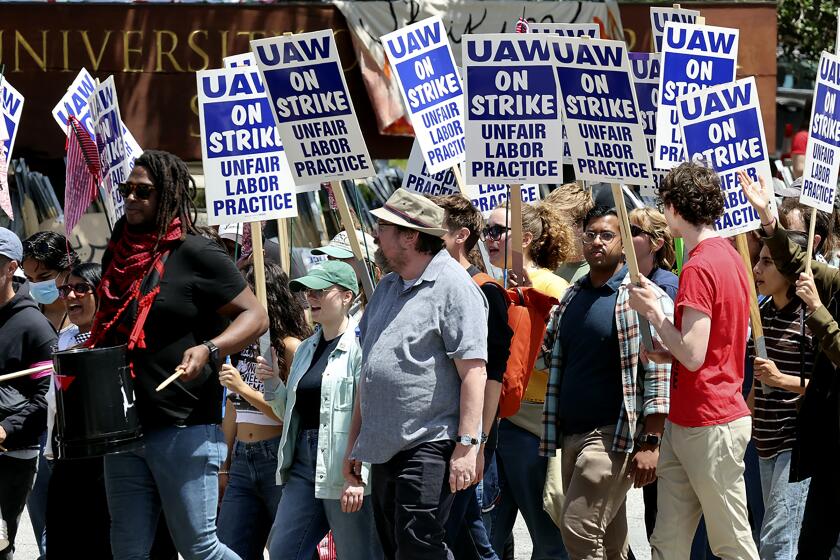The University of California’s Slow Death by Malign Neglect Must Stop : Education: Damaged by pay and staff cuts, with projected growth seen to be zero, the system must rethink its “universal access” mantra.
The University of California is one of the most important engines of economic growth in the state. It turns out a highly skilled work force and produces many of the scientific and technological innovations that keep California’s economy competitive. Unfortunately, UC is also caught in a short-run straitjacket of staff and pay cuts and the long-term trap of zero projected growth.
The toll is already becoming evident. Many of UC’s best and brightest professors--the most marketable--are looking for greener pastures. Tenured professors whose productivity has lagged, and who are thus the least marketable, are most likely to stay. This is a prescription for academic mediocrity and stagnation.
One proposed solution to UC’s fiscal crisis--dating back to at least 1984--is to raise fees for graduate students in professional schools, such as business, law, medicine and dentistry.
Opponents of the fee hike contend that “differential fees” are racist and discriminatory and run counter to the “universal access” policy sacred to California’s education system. Higher graduate fees would mean fewer doctors, lawyers and MBAs drawn from the underprivileged classes. But stripped of its rhetoric, this line of reasoning is less an argument for “low fees for all” than a compelling rationale for more targeted subsidies for the underprivileged few.
Truth be told, the time for graduate-fee differentials is long overdue. Graduate-education costs are substantially higher than undergraduate expenses because of smaller class sizes and the specialized nature of instruction. From a resource-allocation standpoint, fees should reflect these added costs. At the same time, the increased lifetime earnings potential of doctors, lawyers and MBAs makes it fair to charge higher fees.
Yet, UC law, medicine and business students pay only a few hundred dollars more than undergraduates: $4,200 vs. $3,727. By contrast, graduate students at other state universities--Illinois, Michigan, New York, and Virginia, for example--pay roughly twice as much as undergraduates.
While raising graduate-student fees would boost UC in the short run, they are hardly a panacea. At least two other reforms should be on the table--but they are not.
In 1984, when UC’s economic health was last vigorously debated, California had 10% of the nation’s population but it educated 17% of the nation’s college and university students. Little has changed in 10 years, and it’s more than the surf that’s bringing students from other states to our shores--it’s a lucrative taxpayer subsidy for a quality education.
Despite some tightening of the law, many out-of-state students can still qualify for California residency after 12 months--thus entitling them to pay the same low price for education as Californians. This policy takes the concept of “universal access” to an extreme and needs to be further strengthened.
Accordingly, UC administrators should raise graduate fees--sensibly. To be most effective in allocating state resources and raising revenues, fee levels should vary not only by professional school but also by campus, depending on cost differentials and market demand. It would also be wise to grant local campuses the power to establish specific fee levels.
More problematic is the issue of foreign immigration; here the link to UC’s fiscal woes is both subtle and severe.
Over the next decade, the population of California residents under age 18 will grow by more than 30%, while the projected change for the rest of the nation is negative . Much of this difference may be traced to higher birth rates among immigrants to California, particularly children born to non-citizen parents, who, under federal law, are entitled to citizenship. How does this demographic trend affect UC?
Under state law, California’s elementary and secondary school systems are entitled to budgetary dollars before higher education. That means the bulge of immigrant children going through the K-12 system during the next decade is going to drain off an increasing share of the overall education budget.
This problem is compounded because UC also stands behind welfare, Medi-Cal and the prison system in the budgetary line. These spending categories, coupled with the K-12 budget, make up more than 90% of the state’s budget, leaving UC to fight over the scraps. Hence, the UC administration’s dire prediction of zero institutional growth in the next 10 years.
Unless Sacramento works with Washington to address the broad issue of immigration and the specific policy of birthright for children borne on U.S. soil, current trends will continue to create fiscal havoc not just for UC but for California as well.
California can no longer delay facing up to these basic realities and making some choices. If we choose to destroy UC, let’s make it an explicit choice--not one that occurs through malign neglect.*



